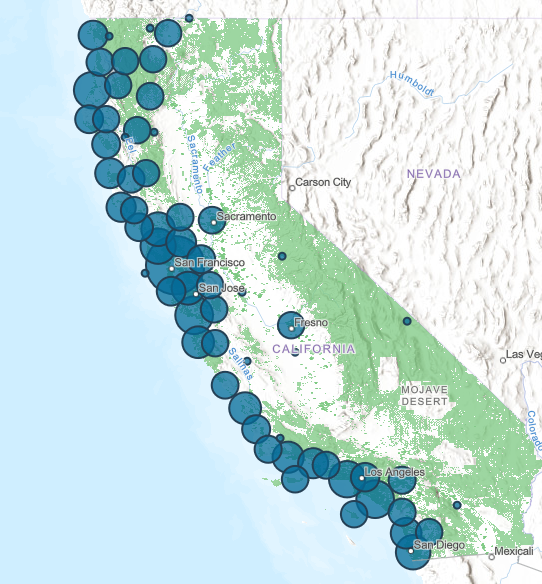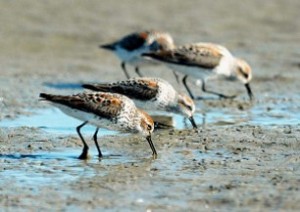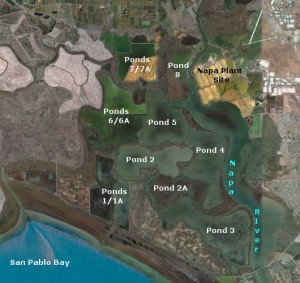Napa River Salt Marsh Restoration Project
The Napa River Salt Marsh Restoration Project is a pioneering effort to restore 10,000 acres of former salt ponds, remnant sloughs, fringing marsh and levees to tidal marsh and other valuable habitats in the North Bay of San Francisco. The project also provides wildlife-oriented public access. The Napa Sonoma Marsh Restoration Group provides an ongoing forum for information sharing about this and other projects in the area.
San Francisco Bay has lost an estimated 85 percent of its historic wetlands to fill or alteration. This dramatic decline in tidal marsh habitats has caused populations of marsh-dependent fish and wildlife to dwindle and has also decreased water quality. Now nearly complete, the Napa River Salt Marsh Restoration Project provides an opportunity to begin to reverse these trends and improve the health of San Francisco Bay for years to come.
Project Goals
The goals of the Napa River Salt Marsh Restoration Project are compatible with the regional goals stated in the Baylands Ecosystem Habitat Goals Report (1999).
Specifically, the goals of the project are to:
- Restore large tracts of connected tidal marsh, with a band of marsh along the Napa River, to benefit
- Special status species, such as the salt marsh harvest mouse, Ridgway’s rail and black rail;
- Endangered fish, such as Delta smelt, Sacramento splittail, steelhead trout, and Chinook salmon; and
- Aquatic animals, including the Dungeness crab, and other species.
- Manage the depths and salinities of salt ponds to create habitat diversity for birds, including
- Shallow areas for shorebirds and dabbling ducks; and
- Deeper areas for diving ducks.
- Provide wildlife-oriented public access and recreation, including
- Fishing;
- Birdwatching;
- Hunting; and
- Environmental education.
Partners
The State Coastal Conservancy played an important role in this project, from contributing to the funds for acquisition of the land to leveraging $3 million in federal funds to complete a feasibility study and final environmental document. The Conservancy partnered with other state agencies on Phases 1 and 2 of implementation, tidal restoration of 3,000 acres and enhancement of an additional 1,800 acres of wetlands.
State agencies also led the draft design of the third and final phase of the project, 2,000 additional acres and a recycled water project to dilute saline water in the former salt ponds. After entering into a project agreement with the California Department of Fish and Wildlife, the U.S. Army Corps of Engineers constructed Phase 3.
The lands are managed by the California Department of Fish and Wildlife as part of the 15,200 acre Napa-Sonoma Marshes State Wildlife Area. It is located across the Napa River from its sister restoration project, the Napa Plant Site Restoration Project.
Scientists will continue to collect and report data to support adaptive management of the site for 15 years after project completion. Wildlife observations have demonstrated a positive, immediate wildlife response to the newly restored areas. Monitoring surveys to date show heavy use of the site by waterfowl and shorebirds and a healthy population of salt marsh harvest mice. In addition, otters and bald eagles have been observed in the area.
Progress to Date
The Napa River Salt Marsh Restoration Project has restored and enhanced 6,800 acres of former salt ponds to tidal marsh and managed ponds. Now complete, the project provides fish and wildlife benefits and public access, including signage and benches.
- Pre-Project: Pond 2A, tidal marsh, 500 acres
- Phase 1: Ponds 3, 4, and 5, tidal marsh, 3,000 acres
- Phase 2: Ponds 1, 1A, and 2, managed ponds, 1,800 acres
- Phase 3: Ponds 6/6A, 7/7A, and 8, managed ponds, 2,000 acres
- Note: remaining acreage consists of fringing tidal marsh, sloughs and levees.
Timeline
1994 – State agencies purchase salt ponds from Cargill
1997 – Pre-Project restoration complete (Pond 2A)
2004 – Final EIR/EIS complete
2005 – State agencies begin Phase 1 (tidal restoration of 3,000 acres) and Phase 2 (enhancement of an additional 1,800 acres)
2006 – Phase 1 complete (Ponds 3, 4, and 5)
2006 – Phase 2 complete (Ponds 1/1A and 2)
2007 – Congress authorizes the project in the Water Resources Development Act
2007 – Scientists release first monitoring report on water quality, vegetation growth, and wildlife presence (which became the Biennial Report) for Phases 1 and 2
2008 – State agencies complete draft design of Phase 3 (restoration of 2,000 acres and integration of a recycled water pipeline to assist with the dilution of hypersaline water)
2010 – Initial development of tidal marsh vegetation in Ponds 3, 4, and 5
2012 – California Department of Fish and Wildlife and U.S. Army Corps of Engineers sign project partnership agreement
2013 – Construction of Phase 3 begins (Ponds 6/6A, 7/7A and 8)
2019 – Phase 3 complete (Ponds 6/6A, 7/7A and 8)
2020 – Scientists continue to collect and report data to support adaptive management of the site for 15 years after project completion.
Contact
For the most recent information on the Napa River Salt Marsh Restoration Project, please contact California Department of Fish and Wildlife Wildlife Biologist, Karen Taylor at Karen.Taylor@wildlife.ca.gov.
San Francisco Bay Area
News
- Coastal Conservancy Awards Grants for Coastal Access, Restoration, and Climate Resilience2/15/2024 – Today, the Board of the State Coastal Conservancy authorized a number of grants to restore, protect, and expand access to the California coast. Grants approved included: A grant of an amount not to exceed $35,000,000 to The Nature Conservancy to complete permitting and implement the first phase of the Ormond Beach Restoration Public Access […] (Read more on Coastal Conservancy Awards...)
- Press Release: State Coastal Conservancy Announces Awards for Coastal Resilience, Public Access, Restoration, and StorytellingSan Luis Obispo – This week, the California State Coastal Conservancy announced more than $39 million in funding for projects to improve public access, climate resilience, habitat values, and inclusion at the coast. “The Coastal Conservancy’s vision is of a beautiful, restored, and accessible coast for current and future Californians. To achieve this, we […] (Read more on Press Release: State...)
- News Release: State Coastal Conservancy Awards $78 Million for Climate Resilience, Public Access, Habitat Restoration and Wildfire Resilience(Sacramento, CA) – Today (6/1/2023), the Board of the State Coastal Conservancy authorized funding totaling nearly $78 million for 34 projects to protect and restore coastal lands, increase coastal resilience to climate change, improve public access to the coast, and reduce the impact of wildfire on coastal lands. “Our California coast is under growing threat […] (Read more on News Release: State...)

 Help Save Sea Otters at Tax Time
Help Save Sea Otters at Tax Time



